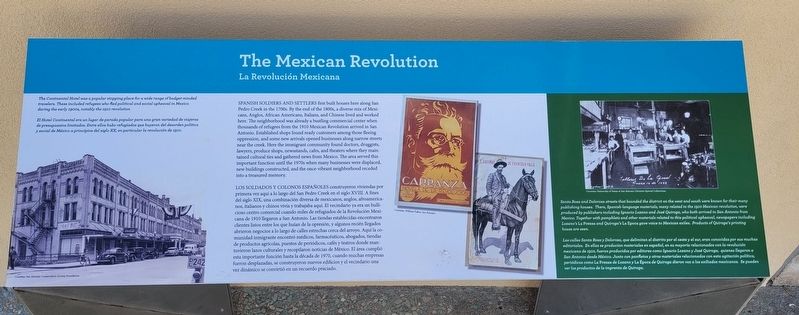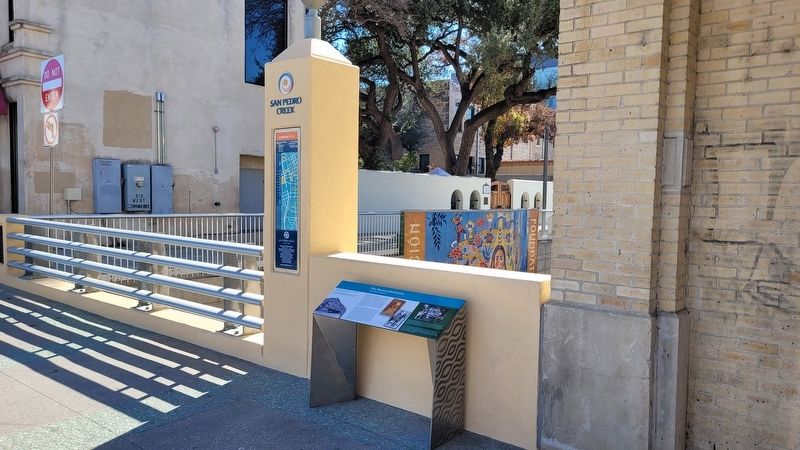Main/Military Plaza in San Antonio in Bexar County, Texas — The American South (West South Central)
The Mexican Revolution
Captions
1: The Continental Hotel was a popular stopping place for a wide range of budget-minded travelers. These included refugees who fled political and social upheaval in Mexico during the early 1900s, notably the 1910 revolution.
2: Santa Rosa and Dolorosa streets that bounded the district on the west and south were known for their many publishing houses. There, Spanish-language materials, many related to the 1910 Mexican revolution, were produced by publishers including Ignacio Lozano and José Quiroga, who both arrived in San Antonio from Mexico. Together with pamphlets and other materials related to this political upheaval, newspapers including Lozano's La Prensa and Quiroga's La Epoca gave voice to Mexican exiles. Products of Quiroga's printing house are seen.
[Spanish Text]
Los Soldados Y Colonos Españoles construyeron viviendas por primera vez aquí a lo largo del San Pedro Creek en el siglo XVIII. A fines del siglo XIX, una combinación diversa de mexicanos, anglos, afroamericanos, italianos y chinos vivía y trabajaba aquí. El vecindario ya era un bullicioso centro comercial cuando miles de refugiados de la Revolución Mexicana de 1910 llegaron a San Antonio. Las tiendas establecidas encontraron clientes listos entre los que huían de la opresión, y algunos recién llegados abrieron negocios a lo largo de calles estrechas cerca del arroyo. Aquí la comunidad inmigrante encontró médicos, farmacéuticos, abogados, tiendas de productos agrícolas, puestos de periódicos, cafés y teatros donde mantuvieron lazos culturales
y recopilaron noticias de México. El área cumplió esta importante función hasta la década de 1970, cuando muchas empresas fueron desplazadas, se construyeron nuevos edificios y el vecindario una vez dinámico se convirtió en un recuerdo preciado.
Subtítulos
1: El Hotel Continental era un lugar de parada popular para una gran variedad de viajeros de presupuestos limitados. Entre ellos hubo refugiados que huyeron del desorden político y social de México a principios del siglo XX, en particular la revolución de 1910.
2: Las calles Santa Rosa y Dolorosa, que delimitan el distrito por el oeste y el sur, eran conocidas por sus muchas editoriales. En ellas se producían materiales en español, en su mayoría relacionados con la revolución mexicana de 1910, fueron producidos por editores como Ignacio Lozano y José Quiroga, quienes llegaron a San Antonio desde México. Junto con panfletos y otros materiales relacionados con esta agitación política, periódicos como La Prensa de Lozano y La Época de Quiroga dieron voz a los exiliados mexicanos. Se pueden ver los productos de la imprenta de Quiroga.
Erected 2022 by San Pedro Creek Cultural Park. (Marker Number 26.)
Topics. This historical marker is listed in these topic lists: Communications • Hispanic Americans • Immigration • Wars, Non-US. A significant historical year for this entry is 1910.
Location. 29° 25.505′ N, 98° 29.783′ W. Marker is in San Antonio, Texas, in Bexar County. It is in Main/Military Plaza. Marker is at the intersection of West Commerce Street and Camaron Street, on the left when traveling west on West Commerce Street. The marker is located along the south side of the Commerce Street Bridge. Touch for map. Marker is at or near this postal address: 320 West Commerce Street, San Antonio TX 78205, United States of America. Touch for directions.
Other nearby markers. At least 8 other markers are within walking distance of this marker. Commerce Street (a few steps from this marker); The New Blossoming of San Pedro Creek (a few steps from this marker); Plaza de Armas: Center of Commerce and Government (a few steps from this marker); The Buried Past is Never Lost (within shouting distance of this marker); Spanish Governor's Palace (within shouting distance of this marker); The Healing Arts West of the Creek (about 300 feet away, measured in a direct line); A Poor Settlement Takes Shape at the Northern Frontier of New Spain (about 300 feet away); Dolorosa Street (about 300 feet away). Touch for a list and map of all markers in San Antonio.
Also see . . . Where beauty meets purpose. San Pedro Creek Culture Park (Submitted on January 21, 2023, by James Hulse of Medina, Texas.)
Credits. This page was last revised on February 2, 2023. It was originally submitted on January 20, 2023, by James Hulse of Medina, Texas. This page has been viewed 83 times since then and 9 times this year. Photos: 1, 2. submitted on January 21, 2023, by James Hulse of Medina, Texas.

